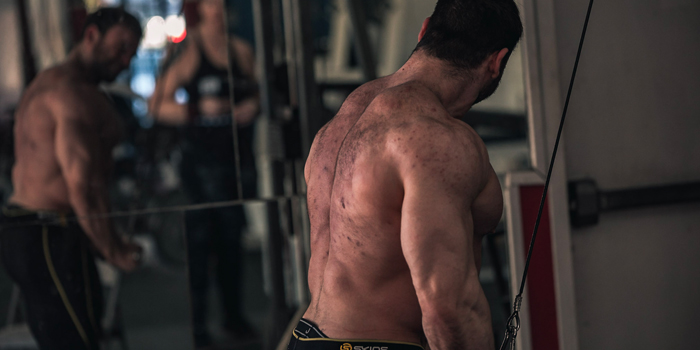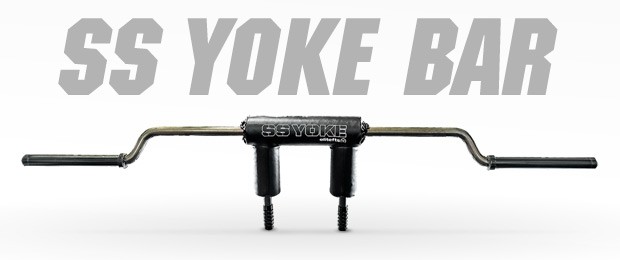
Up until now, this series has been geared towards powerlifters. I firmly believe that bodybuilding movements have tremendous value for the powerlifter. Bodybuilding can build strength by helping you to better target smaller muscles, to emphasize certain muscles over others in compound movements, and to correct imbalances. But the opposite is true, too: powerlifting can have huge benefits for the bodybuilder.
Today we’re looking at the triceps – a muscle group that I really struggle with and, as a result, have spent a lot of time studying and training. Now, if you’re naturally a strong presser, maybe you don’t need to spend a lot of time bringing your triceps up to par. But you can still benefit from learning to train them more efficiently. And, of course, if you’ve got lagging triceps, I don’t need to convince you to read on.
The Function of the Triceps
Mostly, the triceps work to extend the arm at the elbow – the opposite of the biceps. So, any type of pressing (except the Bradford press), pushing, or similar movements will involve the triceps in some way. As you can probably guess, they get a ton of work.
RECENT: Meet Report: Earning My Regrets at the USPA Tribute
Now, a lot of bodybuilders will emphasize that the triceps make up two-thirds of the arm (which might be true, depending on how you measure). For that reason, they argue, the triceps need all of that work to grow. Check out a typical bodybuilding routine for the triceps:
- Dips: 4 sets of 10-12 reps with a 90 second rest period
- Skullcrusher superset with Close-Grip Bench: 3 sets of 10-12 reps each, with no rest in between movements
- Pushdown: 3 sets of 10-12 reps
- Overhead Extension: 3 sets of 10-12 reps
That’s 16 sets of mostly heavy work, just for the triceps. That’s more working sets than I perform in an entire full-body workout.
When you look at the triceps relative to the entire body, rather than just the arm, it’s obvious that the triceps is a fairly small muscle group. And, by the same token, the elbow is a fairly small joint. Neither is well-suited, in my opinion, for a huge amount of work.
If you have overworked the triceps before, then you’ve probably suffered from elbow pain as well. To some degree, aches and pains are unavoidable if you’re going to be lifting heavy, but if they’re holding you back, then you can’t train optimally.
So, rather than just trying to beat the heck out of your triceps, we’re going to try to find the movements that train them most efficiently, so that we can build more size and strength with less work. Here’s where powerlifting comes in.
Finding the Right Movements
In my experience, the best triceps movements do three things:
- They allow you to use a lot of weight, and to steadily use more weight from training session to training session (i.e., to progress). Generally, these are the movements that powerlifters emphasize: heavy, compound ones.
- They put the triceps under a loaded stretch. For example, at the bottom of a dip, your triceps are stretched and supporting your bodyweight. At the bottom of a dumbbell kickback, the triceps aren’t supporting anything.
- They put your body in a position where it’s not easy for other muscles to contribute. In most pressing movements, the shoulders and pecs can do much or even most of the work, meaning that you could have a huge bench and still have relatively weak or lagging triceps.
Of course, there are countless movements that do fit these requirements, and the one that’s best for you will depend on which one fits your particular structure. Here are some less popular movements for you to consider:
- Decline Skullcrusher or Close-Grip Bench Press
- Dip with body held upright (leaning forward emphasizes the pecs)
- Weighted Close-Grip Push-Up
- Bodyweight Triceps Extension
- Yoke Bar JM Press
One big caveat: How you perform these movements is more important than what particular movement you choose. Let’s take a look at an example.
The Yoke Bar JM Press
The JM press is a movement typically reserved for powerlifters, but a whole lot of bodybuilders could benefit from incorporating them into training. In the JM press, the bar is held in the same position as in the start of a competition-style bench, but is then lowered straight down towards the face by pushing the elbows forward and slightly out. The JM press is a great movement, because it allows you to work the triceps with very heavy weights, puts them under a loaded stretch, and largely takes the pecs and shoulders out of the equation (unlike the admittedly similar close-grip bench press).
You can perform the JM press with a straight bar, but it works even better with the elitefts Yoke Bar. You can use the pads of the bar as levers to keep the weight moving in a straight line, so it’s more comfortable and harder to cheat.
Harder, but not impossible. When it comes to bodybuilding, you can cheat on any movement. Quality is key: If you’re not working the target muscle, then you’re wasting your time. To work the triceps maximally using the Yoke Bar JM press, here’s what you should keep in mind:
- Keep the elbows tucked. This is true for most pressing movements, but especially when you’re trying to emphasize the triceps. Keeping the elbows tucked requires external rotation of the shoulders, putting them in a safer position, and keeps your elbows closer to the body, allowing for a greater stretch.
- Keep the bar path straight. With the JM press, in particular, it’s very easy to cheat by using momentum to swing the bar forward off of your chest. This isn’t going to help if your goal is a bigger bench or bigger arms.
- Keep the triceps tight. This applies to virtually every triceps movement – in fact, to virtually every movement you’ll perform while bodybuilding. Keeping the muscle that you’re working tight throughout the entire range of motion allows you to progress far more quickly than if you relax during the eccentric portion of the movement.
- Lock out completely. This should be self-explanatory, but because the triceps extend the elbow joint, if you don’t fully extend that joint, then you’re cheating your triceps out of some work.
- Use a steady cadence. Rep cadence is overlooked by powerlifters and bodybuilders alike, but it’s an important part of productive training. If you’re just sort of hanging out between reps, then you’re not keeping your triceps under constant tension.
It’s true that if you follow these guidelines, you’ll probably end up using a much lighter weight than if, say, you used a little momentum off your chest and didn’t lock out completely. When it comes to powerlifting, that’s a trade-off that you’ll need to consider. Sometimes, using more weight is better than having absolutely perfect form. With bodybuilding, that is rarely true. If you want bigger triceps, forget your ego, lighten the weight, and tighten up.
Here’s a sample triceps routine using the Yoke Bar JM press:
- Competition Bench Press: 5x5 with 80% 1RM
- Yoke Bar JM Press: 4 sets of 20, 15, 12, and 8 reps, resting two minutes between sets and adding weight each set
- Rolling DB Extension: 2 sets with a weight you could use for about 15 reps. Perform each set to failure, resting 4 minutes in between sets.
Wrapping Up
Learning from other strength disciplines is crucial if you want to reach your potential. Just as powerlifters can benefit from bodybuilding movements, so can bodybuilders benefit from powerlifting movements (as long as they’re performed correctly). And incorporating heavy, compound lifts allows you to make your training more efficient and more effective.










